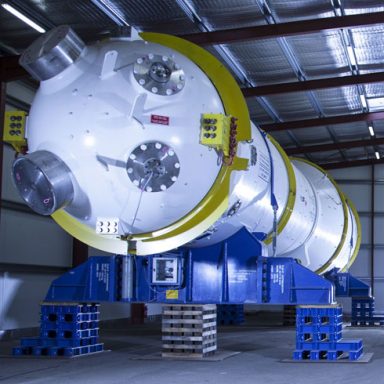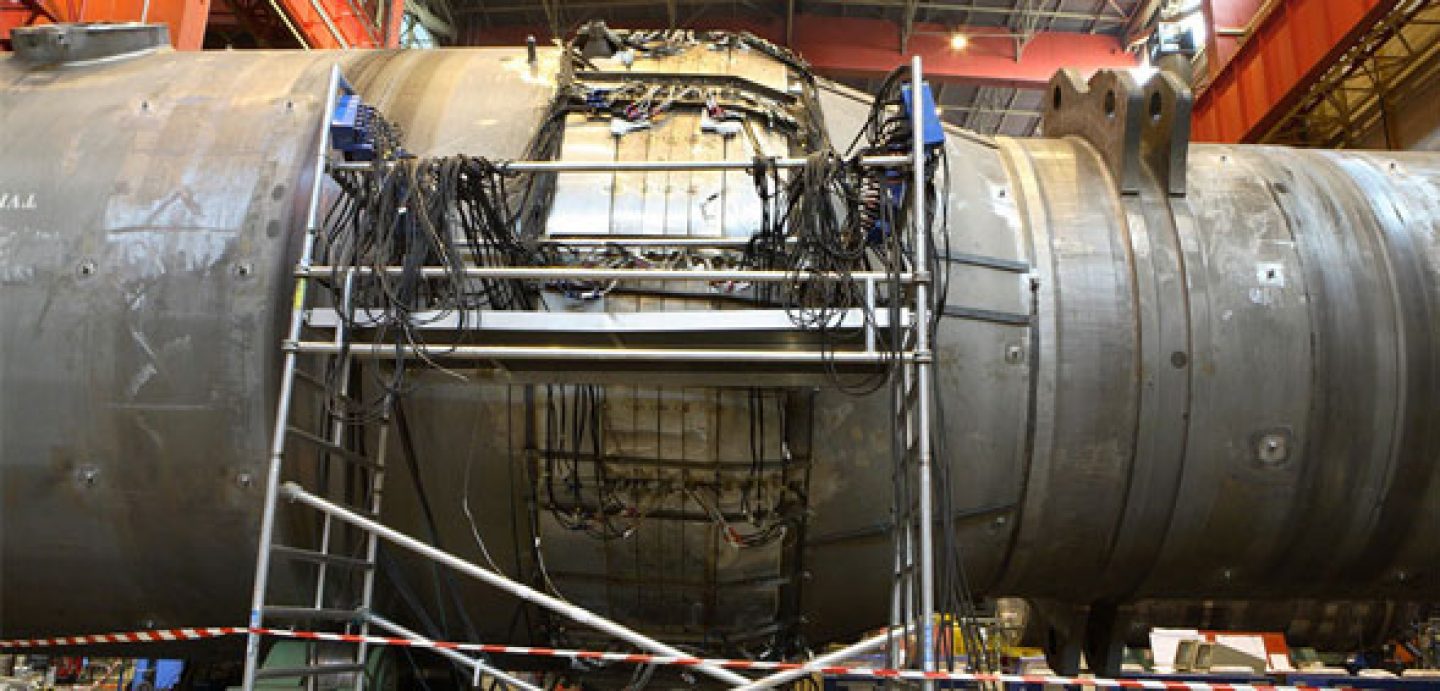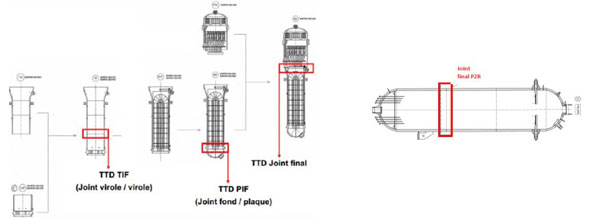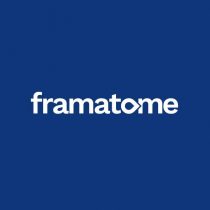Management of a deviation relating to stress-relieving heat treatment of welds

EPR Steam generator, Storage of Flamanville 3 EPR steam generators under controlled atmosphere. © Framatome, Adrien Colomb
In the context of new industrial developments, Framatome detected non-compliance with temperature ranges during the application of certain local stress-relieving heat treatments (SRHT) carried out on welded steam generator and pressurizers seals in the summer of 2019. The purpose of these heat treatments is to relieve residual stresses from welding and obtain the appropriate mechanical characteristics for the seal.
One specific heat treatment process is concerned by this deviation: it is a method using muffles equipped with electrical resistances.
Work conducted by a team of experts has made it possible to characterize the causes, define their consequences and gather the data to establish that the integrity of the components is not questioned. Further studies and tests are continuing to go into this analysis in more detail.
The non-respect of temperature ranges constitutes a deviation from the technical manufacturing standards. As the work to identify the parts concerned by this deviation has progressed, Framatome has kept the relevant operators informed, both in France and abroad.
Framatome has launched a program to consolidate knowledge of the performance characteristics of the other local SRHT processes used on equipment supplied by Framatome, both in plant and on the worksite.

Local stress-relieving heat treatments (SRHT) carried out on welded steam generator
Frequently Asked Questions
The aim of stress-relieving heat treatment (SRHT) is to bring an area that has been welded (a welded seal or coating) to a given temperature for a set period of time, in order to relieve the welding stresses and achieve the right mechanical characteristics for the part. These temperature criteria, i.e ranging from 595° to 620°, are set in the RCC-M manufacturing code (Règles de Conception et Construction Mécanique – Design and Construction Rules for Mechanical Components).
There are two types of stress-relieving heat treatment: one is performed on the entire component in a furnace, and the other is performed locally either through an induction technique process or using an electrical resistance heating system.
Dimensions permitting, SRHT are realized in a furnace which is the case for pressure vessels, closure heads, steam generator and pressurizers sub-assemblies.
When SRHT of the piece or sub-assembly cannot be done in a furnace for dimension reasons and/or at specific manufacturing steps, local heat treatment proves necessary.
The case in which a deviation has been observed involves the resistance method, which uses the technique of muffles equipped with electrical wires.

TTD PIF (Joint fond / plaque): SRHT PIF (primary head / tubesheet weld)
TTD Joint final: SRHT (final weld)
Framatome selected a state of the art technology and chose to industrialize in the early 2000s a local stress-relieving heat treatment process developed by heat experts. This process has made it possible to treat all equipment designs (notably parts of all shapes).
The deviation was identified by Framatome teams in the context of prior industrial developments to the implementation of another process of SRHT in Saint-Marcel plant. It was confirmed by our experts at the end of august 2019 who immediately started to characterize the deviation and the identification of the components concerned.
The ASN, the French Safety Authority, was informed within a week following the deviation confirmation for currently being manufactured equipments. Notification of the deviation was sent via letter dated September 3, 2019. We have informed the operator, EDF, likewise. Joint work sessions have been set up to follow the inventory and the justification processes.
As the work to identify the components concerned is being carried out, Framatome is informing the relevant operators and nuclear safety authorities.
Detecting deviations and dealing with them by proceeding to their characterization is part of our job.
Data from simulations of local stress-relieving heat treatment operations performed at the end of August 2019 have shown that the temperature range of 595 °C to 620 °C specified in the heat treatment procedures applicable in the workshop – which comply with the requirements of the RCC-M manufacturing code – was not maintained. This failure to comply with the temperature requirement constitutes a deviation from the technical manufacturing standard.
Following the work carried out by the Framatome engineering teams, EDF and Framatome have shared with the ASN, the French Safety Authority, justifications showing that the integrity of the components is not questioned.
The ASN, the French Safety Authority, published October the 24th, 2019, a note « Écart de fabrication chez Framatome : traitement thermique de détensionnement des soudures » (Manufacturing deviation within Framatome: stress-relieving heat treatment of welds) stating that affected nuclear power plants can continue to run and that no shutdown is required whilst the necessary controls to the treatment of the deviation are being carried out.
Because of its specificities, further inquiries have been required by the ASN regarding a steam generator of the Fessenheim nuclear power plant no2.
With regards to new components (currently being manufactured or installed), Framatome is handling the non-conformities in the manufacturing file and revises the documentation of the equipment accordingly.
The deviation was identified by Framatome teams in the context of simulations for new industrial developments. Following the detection of the deviation, Framatome engineering teams started to identify the affected components and to carry on studies that eventually showed that integrity of the components concerned has not been called into question.
Work is currently carried out by Framatome engineering and technician teams to put under control the local stress-relieving heat treatment. This work involves the implementation of numerical and physical simulations.
Framatome relies on its engineering and technician teams, who are mostly specialized in mechanics. Since the detection of the deviation, those teams have been gathering and analyzing elements that allow stating that integrity of the components concerned is not called into question.
Steam generators enable heat to be transferred between the reactor coolant system and the secondary system via a large number of inverted U-shaped tubes. Depending on the size of the reactor, there are three or four steam generators per reactor. A steam generator is between 20 and 25 meters high, with a diameter of 4 to 6 meters. It can weigh up to 525 metric tons.
A pressurizer keeps the water in the reactor coolant system (which is heated to a temperature of over 300 °C) under pressure. A pressurizer is up to 14 m high and 3 meters in diameter. When empty, it weighs more than 140 metric tons.
Letters and information notice from the ASN
The ASN is the French Safety Authority for Nuclear. The following links redirect to French content.
- October 24, 2019: (Information Notice) Ecart de fabrication chez Framatome – traitement thermique de détensionnement des soudures
- October 2, 2019: (letter to Framatome – PDF file, 137,60 Kb) Inspection relative à la conformité des matériaux entrant dans la fabrication des ESPN, Usine Framatome à Saint-Marcel (71). INSNP-DEP-2019-0239
- October 1, 2019: (letter to EDF – PDF file, 141,69 Kb) Contrôle des installations nucléaires de base EDF DPN/ DI sur le site de Framatome à Saint-Marcel, Inspection INSSN-DEP-2019-0267 du 18 septembre 2019. Écart relatif au traitement thermique de détensionnement local de certains joints soudés de générateurs de vapeur en exploitation
Communication from EDF
The following link redirect to French content.
- September 18, 2019: EDF’s press release (PDF file, 369 Kb)- Point sur l’écart relatif au référentiel technique de fabrication de composants de réacteurs nucléaires par Framatome
Information note from the IRSN
IRSN is THe Institute for Radiological Protection and Nuclear Safety, the French public expert in nuclear and radiological risks. The following links redirect to French content.
Archives

Access to all communications from Framatome released into our newsroom about this topic.